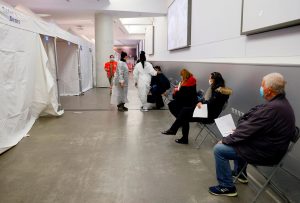It doesn’t necessarily take a brain surgeon to explain redistricting: The act of resizing voting districts to account for changes in population every 10 years.
But it might take a neuroscientist to wrap heads around gerrymandering, the reason why those redrawn districts will warp, bend and twist around a map like cracks in a windshield.
Sam Wang is the director of the Princeton Gerrymandering Project, a team of analysts that seeks to understand and explain instances of partisan gerrymandering — the redrawing of electoral districts to favor one party or group of people. The stated goal of the project is to understand and eliminate partisan gerrymandering, state by state.
By day, Wang is a neuroscientist, seeking to understand how brains interpret sensory experiences.
“Both of them involve making sense out of complicated data patterns,” Wang told Spectrum News, adding: “I think data analysis can take some of those obscure things and make them more clear.”
Redistricting, by itself, is necessary for our representative government to keep up with changes to population growth in communities across the country. The key is ensuring that those processes are done fairly.
Some states establish independent commissions to redraw their maps. Others are done behind closed doors, by elected officials solidifying thier party’s own advantages by packing or diluting blocs of voters.
Wang’s team uses computer simulations and analysis to grade states on whether their electoral maps are overly partisan. Maps are then given grades, ranging from A to F, based on matters of partisan fairness, competitiveness, and the way districts are shaped.
Redrawing district maps to favor one party over another is not necessarily the cornerstone of one political party or another.
“Gerrymandering is an equal opportunity sport in the sense that any time that one party is in charge, there is a temptation to draw a gerrymander,” Wang said.
In New York, a state where Democrats control all branches of state government, a bipartisan commission redrawing the maps couldn’t reach an agreement, so the state’s legislature passed its own maps. As a result, a Republican-leaning district encompassing Staten Island — the most conservative part of New York City — was redrawn to include far more liberal neighborhoods in Brooklyn.
The group graded New York’s Congressional map with an “F” for very uncompetitive maps and huge districts that split county lines more than most maps.
In other parts of the country, like Alabama, Republicans have been accused of packing Democratic leaning Black voters into districts by themselves, consolidating their voting power, but ensuring that they can’t have an broader impact on representation. Alabama hasn’t yet been assigned a letter grade.
But other states, he said, do well by voters: Some states with independent redistricting commissions, like Michigan, Arizona, and Colorado, have been graded to be fairly-minded, without offering an undue advantage toward any particular party.
Wang’s interest in political redistricting began about 20 years ago. In 2013, he noticed that Democrats won 1.4 million more votes than Republicans in races for the House of Representatives, yet Republicans took a 33 seat advantage in the chamber.
This year, he said, Congressional districts are rolling out in such a way that neither party is wholly favored, which could mean that Congress may remain closely divided.
“From a raw power standpoint, that sounds pretty good, but that doesn’t change the fact that there’s less competition everywhere,” Wang said. “If Democrats draw gerrymanders, if Republicans draw gerrymanders, it might be that there’s some kind of stalemate, but the loss of competition leaves voters out of the mix.”
While the United States Supreme Court has cited his research, the high court ruled, 5-4, in 2019 that federal courts should not be involved in cases of partisan gerrymandering; that political questions are outside the “courts’ competence … and therefore beyond the courts’ jurisdiction,” wrote Chief Justice John Roberts.
The court’s liberal wing — then anchored by Justices Elena Kagan, Sonia Sotomayor, Ruth Bader Ginsburg and Stephen Breyer — dissented in the consolidated cases of Lamon v. Benisek and Rucho v. Common Cause.
The gerrymanders left empowered by the majority, Kagan said, “promoted partisanship above respect for the popular will,” and “encouraged a politics of polarization and dysfunction.”
“One of my briefs was quoted by the Chief Justice saying, ‘we have no quarrel with the plaintffs’ math’…and then the next statement is, ‘the point is not the math,’ and I thought, ‘oh, dude,’” Wang recalled.
Wang feels that the math is, indeed, the point — that the math, properly considered by commissions and officials in power, can make elections fairer and discourage blatant partisanship. And the math will continue to be his focus, when he’s not researching brain activity.




